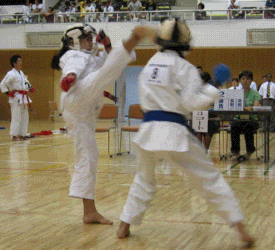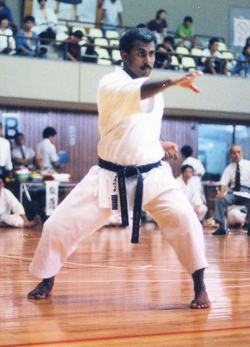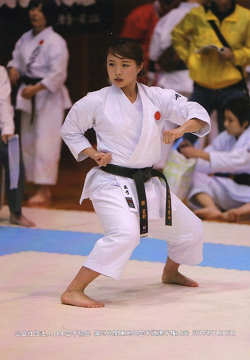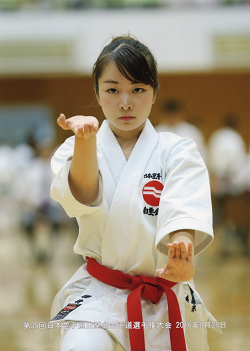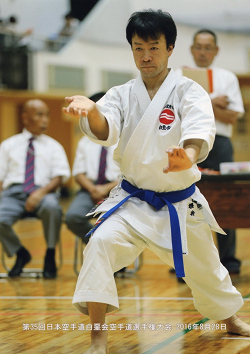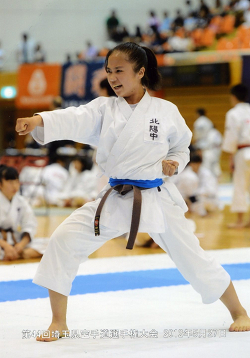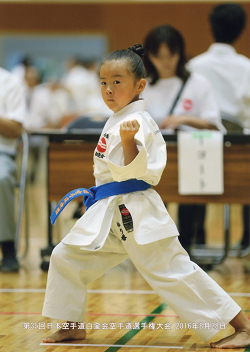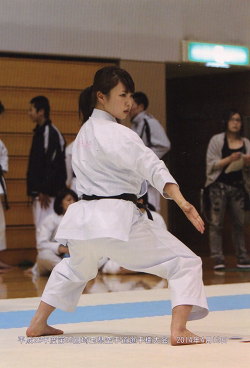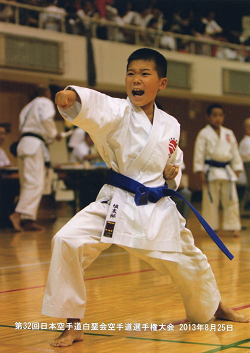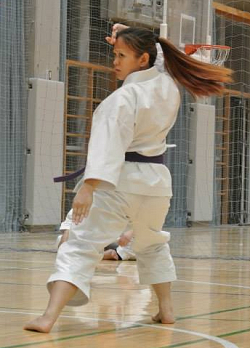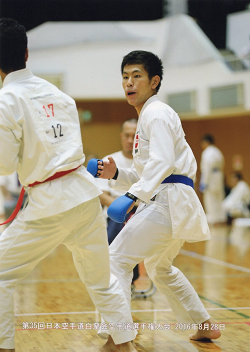Japan Karate Do Hakua-kai・Shotokan Ryu Karate
TEL.090-4709-4766
Higasi Ryoke 1-11-3 Kawaguchi City Saitamaken Japan
Kihon (基本)
Kihon is a Japanese term meaning "basics" or "fundamentals."The term is used to refer to the basic techniques that are taught and practiced as the foundation of most Japanese martial arts.The practice and mastery of kihon is essential to all advanced training,and includes the practice of correct body form and breathing, while practicing basics such as stances, punches,kicks, blocks, and thrusts, but it also includes basic representative kata.Kihon is not only practicing of techniques, it is also the karateka fostering the correct spirit and attitude at all times.Kihon techniques tend to be practiced often,in many cases during each practice session. They are considered fundamental to mastery and improvement of all movements of greater complexity.
Kihon in martial arts can be seen as analogous to basic skills in, for example, basketball.Professional NBA players continue to practice dribbling, passing, free throws, jump shots,etc. in an effort to maintain and perfect the more complex skills used during a basketball game.Styles of karate differ greatly in the emphasis placed on kihon.
Kihon may be practiced as "floor exercises", where the same technique or combination is repeated multiple times as the students move back and forth across the floor. Japanese kihon training is notorious for extended periods of kihon training. This style of practice is believed to ingrain the techniques into the muscle memory of the karateka.Some styles employ "kihon kata" in teaching beginners.
Additionally, kihon may take the form of prearranged partner drills whereby two students face each other and alternate execution of a technique. This approach combines repetition with training in distancing. Targets for punching and kicking, such as bags, shields, or dummies, are generally used at more advanced stages of kihon training to strengthen muscles, bones,and skin.The basic techniques of blocking, punching, striking and kicking are both the beginning of karate and the altimate goal.
Although only a matter of months may be sufficient to learn them, complete mastery may not come even after a lifetime of training.The student must practice regularly,with maximum concentration and effort in the execution of each and every movement.This will not be sufficient, however, unless the techniques are scientifically sound and the training systematic and properly scheduled. To be effective, training must be conducted on the basis of correct physical and physiological principles.
It may come as a surprise to many to know that the techniques created and refined through long and continuous practice by the early karate student have been found to accord with modern scientific principles. And the more they are studied, the more this proves to be true.This is not to say that there are no unsolved problems, but these mustawait further study.Further refinement of karate is quite probable, as techniques are analyzed in an unceasing effort to improve them through a scientific approach.In order to benefit from his training,the student should have a good understanding of following primary points.
The weapons of karate-do are various parts of the human body.Every part that can be effective in defense or offense is used,It is in this respect that karate-do is different from the other martial arts.Systematic training is the only way to develop weapons that will be ready for use at any time,in any place,in any situation.It is most important that training of every part of the body be continuous and methodical.Intensive training alone is not abequate to convert the parts of the body into powerful weapons.
Tachikata(立ち方) Stance
Fundamental to the improvement of one's karate technique is the acquisition of correct andbalanced from.A strong technique is born from a firm, sure-footed stance.Whethre the technique is offensive or defensive, it will not be effective if the body lacks balance and stability. The ability to counter an attack under any circumstances depends largely on the maintenance of correct form. For techniques to be powerful, fast,accurate and smoothly executed, they must be launchedfrom a strong and stable base.In karate stance (tachikata) refers to the position of the lower body,the hips and the legs, which literally carry the upper body.Thus techniques are at their best when form is at theoptimum. The moment when this is important is the instant in which a techniqueis executed. Good form is not rigid. Overconcentration on maintaining a firm and stable position will result in loss of mobility, whichis necessary for the succeeding movement.It is well to remember that skyscrapers can be built only on a solid foundation.
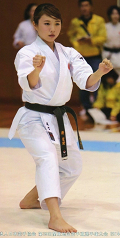 |
Requirements of Good Stance The basis of executing a technique is correct stance plus balance and the harmonious coordination of parts of the body, and all must work together at the same time.In this way, techniques become fast and powerful.The delicate control that is required depends on and is guided by good stance. Classification of Stances Stances can be divided into two types according to the way the knees are used in relation to the center of gravity. 1. Outside tension stance, the knees are pressed strongly out ward from the mid line connecting the body's center of gravity and the floor,as in Zenkutsu dachi, Kiba dachi,Kokutsu dachi and Shiko dachi. |
| 2. Inside tension stance, the knees are twisted inward,as in Uchihachuji dachi,Sanchin dachi and Nekoashi dachi. | |
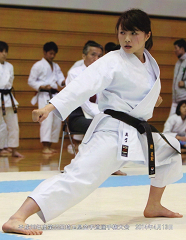 |
The Important Points Spreading the Knees Imagine a line connecting the knees and extending on outward to the side.Spread the knees strongly outward on the extended line. Knees and Toes Whatever the stance, and the toes of each leg should point in the same direction. Knees and Ankles Knees and ankles must be bent sufficiently and strongly Soles The entire surface of the soles should be in reliable contact with the floor.The feeling is that of strong adhesion. |
| Position of the Hips According to the stance,the position of the hips must be accurately differentiated. Center of Gravity For strength and stability, it is necessity to have the feeling that the connecting the navel and the anus is as shorts as possible. The height of the center of gravity is also a factor. The lower the center of gravity, the more stables the stance. |
|
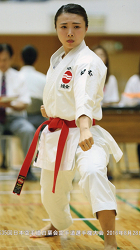 |
Katachi (形) Form Correct form is always closely related to the principles of physics and physiology.Prerequisites of correct form are good balance, a high degree of stability and the order of movements of each part of the body, since movements are made in quick succession in a short period of time.This is specially true in karate because punching and kicking are vital to the art. The need for good balance can be seen particularly in kicking,where the body is usually supported by one leg. To withstand the great impact when a blow is landed, stability of all joints in he arms and hands is necessary.With changing situations and different technique, the center of gravity changes, shifting to the left, right, front, back. This cannot be done unless the nerves and muscles are well trained. Again, standing on one foot for too long will open one |
| attack, so balance must be constantly shifted from one foot to the other.The karate student must mothavoid giving an opening and be prepared for the next attack. | |
Uke no Go Gensoku (受けの五原則)
| Uke no Go Gensoku (受けの五原則) The following principles are what all Karateka practitioners strive to master.Although it is an endiess task... |
| Rakka : Like a falling flower To block with such force that if the technique were applied to the trunk of a tree it would lose all of its flowers.A block should be executed so decisively that it not only halts an opponent's attack but utterly defeats it with a single technique. |
| Ryusui : Like flowing water To flow with your opponents movements,using them against him and as an aid to your defense respond to your oppnent using fluid movement. |
| Kusshin : "Darting out and in" Control of an attack that uses body movement originating in the knees.Keep your spine straight and use your knees to control your height, giving you balance and the strength of your legs so that little effort is required to control the attack.Springing,A reflexive,darting "out and in" kind of body shifting from any angle. |
| Tenshin : Tai sabaki, (rolling the body by stepping out) Essentially avoiding your opponent's attack using body movement.Stepping out in all directions. |
| Hangeki : Counter attack When the need arises,respond to your opponents attacks with decisive,powerful counter-attacks.By utilizing the first four principles you may never need to implement the fifth,but if required you should apply you whole mind and body to the counter. |
 |
Kiai (Spirit-meeting or Energy-shout) The Kiai is the shout at the end of a technique and in conjunction with the expulsion of air (Kime) Will maximize the power of the movement. It also had the effect of surprising an opponent and may momentarily paralyze their response. The concept of KI is at the roof of oll martial arts and Japanese philosophy. KI is the spirit and energy along with the breath meeting AI at the moment of impact. Developing your KIAI is very important. It is notjust a shout or a screech from the throat. If you put your hand on the stomach and cough you willfeel the muscles of your abdomen contract. This in fact is the start of your 'KIAI'. |
| First understand the principles and the breathing method Kime as explained,then replace the biting action with your shout 'KIAI'.It will start as a growl from the pit of the stomach but when completed the sound produced will vary from one to another. | |
Kokyu (呼吸) Breathing
Breathing is coordinated with the execution of a technique, specifically inhaling when blocking, exhaling when focusing technique is executed, and exhaling when successive techniques are performed.Breathing should not be uniform; it should change with changing situations.When inhaling, fill the lungs full, but when exhaling do not expel all the air.Leave about 20 percent in the lungs. Exhaling completely will leave the body limp. One will not be able to block even a weak blow, nor will be able to prepare for the next movement.
The karateka should coordinate breathing with her techniques. Breathing enhances the karateka's ability to relax and concentrate maximum power in her techniques.Correct breathing -- fully exhaling when finishing a strike, for example-- is necessary to developing kime. The karateka should not breathe in a uniform manner; her breathing should change with the situation. Proper inhaling fills the lungs completely.Proper exhaling leaves the lungs about 20 percent full -- exhaling completely makes the body limp, leaving the karateka vulnerable to even a weak attack.
Kime (決め)
Kime is a Japanese word. It is the noun form of the verb "kimeru,"which means "to decide,""to conclude," or" focusing" ,etc In English, its general meaning is "deciding." or "focusing"Kime is a commonly-used Japanese martial arts term. In karate it can mean"power" and/or"focus," describing the instantaneous tensing at the correct moment during a technique.
The tension at this time is mostly focused on the dantian ("hara") and abdomen.In other budō, the term refers to attacking a pressure point.In all cases, certain finality is implied.
Without breath there is on life. Without Kime your karate is lifeless.It is essential that you understand that all karate techniques must be performed with Kime.
Kime is the focusing of mental energy,breathing and physical force culminating in a single striking point.
Karate is not whole without all these elements.
The key to kime is the breathing.Any physical activity requires correct breathing,witch works with the body not against it.
The grunts and groans athletes make are not for effect; a student is using his breathing along with his muscles to explode with maximum effect, producing the most potent force possible.No effort is wasted.
There are various methods of breathing, but the basic method for beginners is: 'One breath one technique'.In a relaxed but controlled manner breathe out through a slightly opened ,mouth complete the breath and technique at the same moment closing your mouth instantly as if biting. Simultaneously tense the abdomen, locking the rest of your muscles for a fraction of a second before relaxing and breathing in normally.As you tense and lock the muscles of the abdomen, the buttocks should be clenched so that the abdomen lifts up and forward
Maai (間合い
Koshi (腰) Hips
The hips are located at approximately at the center of the human body,and their movement plays a crucial role in the execution of various types of karate techniques.The lowerabdomen, particularly the rotation of the hips, which adds to the power of the upper body, creates the explosive power of the focusing blow. Besides being a source of power, the hips provide the basis for a stable spirit, correct form and maintenance of good balance. In karate, the advice is often given to "punch with your hips", "kick with your hips", "strike with your hips" and "block with your hips.
Rotating the hips
A technique cannot be sharp and decisive unless the rotation of the hips is utilized to the fullest. Basically, training in rotation of the hips begins with fast movement on a fairly large scale. As one advances in skill, the rotation should be fast but on a small scale.
Eventually the feeling should be one of the hips turning in a sharp cutting movement.
As for techniques, there are those with a fast, strong, large movement and those with a rapid, sharp, small movement. It is essential to learn which technique is appropriate to which situation. This can only be done by accumulating practice.Important in beginning training is the mastery of large-scale technique that is fast,strong, up to the standard and that travels the correct route.
The faster the rotation of the hips, the better, for this gives an abundance of speed to the technique. The principle of the rotation is the same as that of a spring.The tighter the spring is wound, the greater will be the force when it is released. Rotating the hips (to the half-front-facing position) and blocking is like winding the spring. Rotating the hips the other way (to the original position) and punching is like releasing the spring. Withdrawing arm (hiki-te)-Hip rotation (block)-Reverse hip rotation-Punch.
The Important Points
1. Keep the hips horizontal to the floor, and rotate them smoothly.
2. Do not allow either hip to raise; always keep them level.
3. Do not turn the shoulders only. Turn the upper body smoothly and in unison with the hips.
4. Always keep the torso upright,taking care that the buttocks do not protrude to the rear.
In many Karate techniques the power does come from the rotation of the hips. To understand it, try swinging a baseball bat without allowing your hips to rotate. You can't generate power. In the case of the baseball bat the hip rotation comes quite (but not completely) naturally. Much of Karate training is about leaning how to employ the hip rotation to create speed, power and disguise in the techniques. I can't begin to explain it, because you need to train in Karate for a few years to learn it.
If I could explain it here nobody would need to train. As for the legs,the legs support the hips so yes they are very much involved!
The hips are a crucial, yet oft-neglected component in executing karate techniques. Hip rotation adds power to the upper body, and is thus essential to strong blocks and punches. The hips' proximity to the body's center of gravity make them the foundation of strong, stable movements, good balance, and proper form.The karateka cannot move as smoothly, quickly, or powerfully if the hips are passive.For this reason, teachers often remind their students to "block with your hips,""punch with your hips,""strike with your hips" and "kick from your hips."
Hiki te (引き手) The Withdrawing Hand
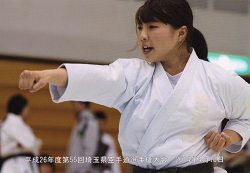 |
Hiki te (引き手) The withdrawing hand (Hikite) leads rotation of the hips. When executing a technique, the withdrawing hand must move strongly,quickly and sufficiently. If not, the technique will not reach its maximu effectiveness. Another important point is that both arms must move at exactly the same time If a technique is being executed with the right hand, it is usual for the left elbow to be drawn straight back. |
| However, when biocking in the half-front-facing position, it is better if the elbow comes back somewhat in the direction of the spine, rather than straight back. When striking in a wide arc, the withdrawing arm should also describe a wide arc. In other words, if the technique is executed in a straight line, the other arm withdraws in a straight line. If the technique is arclike, the other arm travels in an arc. It is not too much to say that exellent techniques are born from a strong,fast withdrawing arm. |
|
Rhythm and Timing
In any sport, the performance of a top athlete is very rhythmical. The applies olso in Karate. Whether it is a deciisive technique-punching, kicking, blocking or counterattacking, and no matter how strong or accurate the technique may be otherwise,timing must be precise.Being the least bit early or the least is nothing but a mistake.The moment a technique is completed, you should take a new stance, one in whi
Zanshin (残心)
Zanshin (残心) is a term used in the Japanese martial arts. It refers to a state of awareness – of relaxed alertness. The literal translation of zanshin is "remaining mind".In several martial arts, zanshin refers more narrowly to the body's posture after a technique is executed.In various martial arts
In Karate,zanshin is the state of total awareness.It means being aware of one's surroundings and enemies, while being prepared to react
In Kyudo zanshin means the body posture after the loosing of an arrow;the posture is intended to reflect the higher meaning of zanshin,which is a mental aspect maintained before, during, and after an action.
In the context of Kendo,zanshin is the continued state of spirit, mental alertness and physical readiness to meet the situation (such as an opposing attack) that must be maintained when one returns to kamae after attacking. It is one of the essential elements that define a good attack.
During the practice of Aikido the usual method of practicing zanshin is to focus on the just-thrown uke, or opponent, while holding kamae and maintaining awareness in case there are additional attacks or attackers. In Iwama Style training, zanshin is practiced as general awareness of one's surroundings, of which uke is just a small part
TEL. 090-4709-4766 FAX. 048-225-1299
Email : hakuakai_mail@yahoo.co.jp
Email : agalawatta1_29@yahoo.co.jp
Japan Karate Do Hakua-kai
